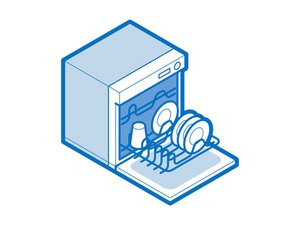I repair and resell used dishwashers as a retirement hobby. After having examined many dishwashers that were replaced because they wouldn't drain, the largest percentage of them were simply because of a clogged drain hose or pump strainer. Too many people seem to think that the dishwasher is first cousin to a garbage disposal. It is not. Even if the instructions state that you do not need to pre-rinse dishes, you should pre-rinse them anyway. The macerators in the dishwashers(the thing that grinds up the food particles, slightly similar to the one in a disposal) are designed to grind up small, soft bits of food, not leftover steak scraps, popsicle sticks, wire bag twist ties (or even plastic ones), paper and plastic jar lables, etc. Yes, I have found all this and more in the pumps). This stuff will clog or possibly destroy the pump/macerator assembly, resulting in a costly repair or replacement of the dishwasher. Sometimes, if enough garbage makes it past the pump and is drained, it begins to collect in the drain hose, and will slowly build up over time to the point where, lo and behold, it will no longer drain. easy fix for that is to first remove the drain hose end from the nipple it's connected to on the sink or disposal, put the end in a bucket, then fill and drain the dishwasher to see if a garbage clog will simply blow out. If that doesn't work, but you see a small dribble of water, you may have to pull the dishwasher out and remove the hose from it to clean it out. Don't forget that there's still water in the unit, so put a drain pan under it before removing the hose, or even better, if you have the unit completely out of it's hole, just tilt it onto it's back before pulling the hose. do not tilt it onto it's side or front, or you'll have the water running out, or into the door cavity, possibly doing damage to the controls.
Bu yanıt yardımcı oldu mu?
Oy verildi
Geri al
Puan
26
İptal
Bu yoruma uygun yeri bulmak için bu konuyu kaydırın. Ardından, taşımak için "Bu yazıya yorum ekle"ye tıklayın.

 2
2  2
2  1
1 






35 Yorum
Thanks for all the suggestions! I will work on it soon and see if any of these work.
Gary tarafından
I had this problem, and after spending a couple of hours taking everything apart and cleaning it, I saw a posting about the check valve assembly that is located right near the motor. I took it off and found a grapefruit seed was lodged in there and preventing the water from flowing through the assembly. Diagnosis is often the most time consuming and difficult part of a fix. Had I known this was the problem, I could have corrected it about one half hour. From now on, my wife and I are going to rinse all dishes prior to putting them in the dishwasher. Lesson learned!!
Bill1907 tarafından
Most Maytag Dishwashers have a 4 second refill of fresh water at the cycle complete to keep the pump wet (seals). This may be heard with the solenoid energizing and the water flowing at the cycle end when running a rinse only cycle. Generally the water is barely visible if at all. On my MDB9600AWW, pushing the reset button once will start a cycle, second push begins drain for 2 min as displayed, then it will fill for the 4 seconds or so.
Gordon tarafından
My problem is similar but only occurs long after the cycle is completed. When the cycle is done, there is no water in the bottom. Hours later there will be an inch to 2 inches of clean water in the bottom. When I hit the Cancel . button, the water is pumped out into the garbage disposal fine and the bottom of the unit is clean. We is a new problem to the unit that has functioned for 8 years without issue. So I don't think it is a clogged hose or malfunctioning pump. Where would you suggest I start?
Carol Yenger tarafından
The most likely cause is that a piece of debris from mineral deposits stuck in the inlet water valve. The opening in the valve is very small and it doesn't take much for a flake of the minerals to become lodged in there and cause a very slow leak of the water into the dishwasher tub. If this is the problem, you should be able to look inside the dishwasher at where the water enters the tub (usually on the left side wall of the tub) to see of there's a very slow leak coming from there. When things are working correctly (inlet valve not leaking) it should be dry. If you see any water at all coming from it then the inlet valve is leaking. Replacement is relatively easy and should not cost an arm and a leg to replace, and replacement is the best option in this case.
Al Seaver tarafından
30 tane daha yorum göster